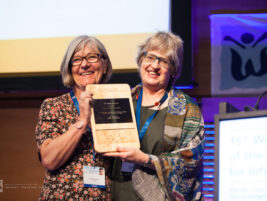I was delighted and excited when it was first announced in Paris two years ago that the next WAIMH conference would take place in Yokohama. It was obvious to me that I would attend, despite the distance, the expense, and the differences – and perhaps precisely because of it. First in Tokyo, and then throughout the three weeks that we toured Japan, I began to comprehend the extend to which this country – its inhabitants, its culture, customs, habits, flavors and scenery – is unlike anything we from the West are familiar with. Japan is different, fascinating, intriguing.
I hoped that attending the conference would be an opportunity for me to attempt to understand the world and mentality of the Japanese people, for which I diligently prepared and read during the year preceding the trip. That was why I chose to participate in lectures and panel discussions given by my Japanese colleagues, and workshops which touched upon the unique aspects of the clinical work done in Japan. To say that, ultimately, I was able to understand the Japanese mentality, or come nearer to comprehending the Japanese mind – no, I cannot. Perhaps it is just not necessary. Perhaps what is important is to experience and absorb the spell which this country casts over you, and be satisfied with what you choose to take with you from your encounter with it.
It is not my intention to describe the enormously rich culture that I discovered during my trip – the magnificent temples, the religious tolerance, the fascinating museums and their captivating esthetics. Instead, I would like to share a few personal experiences on the human and interpersonal level, and some of my observations regarding the patterns of communication and behavioral codes that I encountered. Perhaps the best place to start is the conference’s opening ceremony.
A magnificent convention center in Minato Mirai 21, Yokohama’s beautiful, ultra-modern district with its impressive skyscraper architecture. A large auditorium, an air of festivity and excitement, over 2,000 participants, two-thirds of whom are locals. A large stage, a striking flower arrangement in one corner. Conspicuous in its absence – a desk on the stage for the lecturers, with the names of the speakers and a chairperson to lead the ceremony. Precisely at the appointed time, without preamble and without any announcement to prepare us for what was about to happen, pretty Japanese music began playing in the background, and the lights on the stage began changing to the tune. A young lady, who I innocently thought was the moderator for the evening, appeared on stage. In a pleasant voice, standing in the middle of a circle of light, she read a moving poem, alternating between Japanese and English. A quarter of an hour later, an unseen voice was heard, announcing the first speaker to take the stage and deliver his speech…
Indeed, a different experience, very esthetic, rather sterile. I missed the human contact, the direct touch.
On a personal level, I was exposed to a fascinating culture, to a society of striking and amazing contrasts: tradition versus progress; abundance versus minimalism; the Obon festival and its attendant beliefs versus “temples” of electronics and endless gadgets; the serenity and tranquility of Japanese gardens versus the noise and ringing of the betting machines in the gambling halls; the geishas in the Gion district versus the young people in Harajuku; Kyoto’s small traditional wooden houses versus its ultra-modern train station; kimonos and yukatas versus designer clothes and brandname fashion.
In spite of the feeling of strangeness that accompanied me throughout the trip, and the sense of distancing and alienation that I sometimes felt in my encounters with the Japanese, it was impossible not to be enchanted by the remarkable cleanliness, the politeness, the willingness to help, the manners, obedience, order, serenity and quiet that surrounds you at all times.
The first of August, the first day of the conference, was a holiday marking the 150th anniversary of the opening of Yokohama Harbor. The streets teemed with young people wearing colorful traditional garments, and in the evening the festivities reached their peak with a spectacular hour-long fireworks display. Instead of watching the show from the windows of the convention center, we went down to the water’s edge to join the thousands of Japanese – clusters of young people, couples, families with small children and elderly parents – who sat on mats, merrily eating and drinking. No less fascinating than watching the fireworks themselves was watching the behavior of the throngs of people during the evening and when the celebration ended. Festivity was in the air, excitement, shouts of joy and encouragement, and lots of emptied beer bottles. In spite of the enormous size of the enthusiastic crowd, no one pushed, no one cursed, no one shouted or argued, even when a municipal inspector asked the crowds to clear the passageways. It was enthralling to observe that even though everyone wanted a good place to sit, everyone respected the other person’s space without trying to encroach upon it. And even more impressive was the highly disciplined manner in which people took their leave of the place.
The sight of thousands of people moving in an orderly flow, with almost no noise and no disorder, a great, quiet human river, was unreal. And at the end of the evening, after the entire crowd had gone, the area was spotless; no cigarette butts on the ground, no discarded bottles or empty snack bags to attest to the mass celebration that had just taken place. Where I come from, and in other places I visited, you don’t find such conduct.
You might ask – is such behavior real or fake? The question is appropriate, and I assume the Japanese pay a high price for the obedience, the discipline and the emotional restraint that one sees all around. However, as a stranger in a foreign city, lost and helpless without the constant presence of a local guide, it was a pleasant feeling that created an easygoing atmosphere; you felt you could wander about everywhere, in every district and at any hour without worry or fear. You could be what you were – a foreigner, different – without feeling that you were attracting undue attention. You remain anonymous.
More than once, during a visit to one of the beautiful gardens, or when wandering about the narrow picturesque streets of the villages in the Japanese Alps, or during rush hour in the crowded but unbelievably quiet streets of a metropolis like Tokyo, or when I was lost and didn’t know which direction to take, I would suddenly be approached by a smiling Japanese face, and without our understanding one another, someone would spend many minutes accompanying me to my destination. Or in the midst of standing on the platform of the underground train station trying to figure out where I am, a young, rather threatening-looking young man attached to his cell phone would approach, without hesitation and of his own accord, would make a phone call, and in two minutes would rescue me from the confusion and give me precise information – at those moments I felt I could understand and be in touch with the word amae which Prof. Hisako Watanabe mentioned in her lectures, and whose meaning at the time, I am embarrassed to say, I could not grasp. This word exists only in Japanese, denoting empathy, confidence and trust, and it touched me personally in small human encounters. The sentence “Amae encompasses all human relationships” – accompanied me repeatedly, enabling me to bridge the gaps and learn to accept them.
On more than one occasion, I wondered how I could feel so at ease and comfortable in a place where almost everything was foreign and different, where there was no common language, and communication was limited and difficult. How could I understand the discrepancy between the niceness of the people I met, their generosity and desire to help, and the emotional reserve, the masking of emotions and the remarkable absence of any expression of feeling and affection in their behavior and way of communicating – which I observed on the street and also experienced on the interpersonal level. This is one of those contrasts that strike you… and to add to the confusion, uncertainty and the difficulties of communication, the Japanese never say “no.” The word doesn’t exist. At times you just don’t know whether the “yes,” or the positive shake of the head, means “yes,” – or “no”…
As a person who loves babies and young children, and who is a compulsive observer of them, I was amazed to watch the mode of crying of little Japanese children. In my country, Israel, such behavior would hardly attract any attention, and would generally be interpreted as a sign of the infant’s discomfort. Only on one occasion in our three weeks in Japan did I see a Japanese baby throw a tantrum, and that was at breakfast in a hotel in Yokohama! I hardly heard babies cry and never heard them scream. And while on the subject, I was surprised at how few pregnant women I saw around.
The babies take me back to the conference. One of the workshops I participated in, which was a very interesting experience for me, was “Buddhism in Infancy.” The workshop approached the Buddhism/ infancy dialogue from various perspectives.
I will mention only the intriguing lecture of Prof. Vimala Inoue of the University of Kyosan. His impressive appearance lent an air of calm that reflected the content matter of his lecture as he presented the process and principles of meditation in a simple, yet serious manner. He deemed the Buddhist practice of mindfulness (bare attention) with awareness of breath an underlying practice, regarding it as a “holding environment.” He viewed mindfulness as a means for investigating the intergenerational transmission of parenting practices, and spoke about unconditional love, compassion, sympathetic joy; and about hate, envy, indifference and culpability – as enemies of love.
The workshop included lectures by Maria Pozzi-Monzo (Great Britain) and Stephen Malloch (Australia), each relating from their own personal and different perspective how Buddhism affected and shaped their way of thinking and their clinical work. For me, this was a fascinating opportunity to hear a dialogue between psychoanalysis and Buddhism in which they were not presented as two extremes or as two modes of thinking that have no point of intersection.
To conclude – in her two lectures, Prof. Watanabe stressed the importance that Japanese society attaches to small things. This is reflected in the values of that society: simple; small; slow; silent; sincere; sensitive; steady; strong.
Three weeks later, at the end of an amazing and fascinating trip, I can say that these words characterize much of what I experienced in my encounter with Japanese culture. I hope they will remain part of my personal Japanese experience, which I will continue to lock away in my heart.
Back from Yokohama – Impressions from the Land of the Rising Sun
Authors
Guttman-Avner, Neta,
PhD, Psychoanalyst,
Tel-Aviv, Israel








